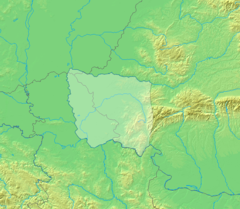 Global Information
Global InformationBanat Republic information
Banat Republic
| |||||||||||
|---|---|---|---|---|---|---|---|---|---|---|---|
| 1918–1919 | |||||||||||
 Flag used during the Republic's proclamation | |||||||||||
| Anthem: Himnusz La Marseillaise | |||||||||||

Modern
Hungary Modern
Romania Modern
Serbia Banat
Republic Claimed territory, superimposed over modern-day borders. | |||||||||||
| Status | Unrecognized state Client state of the Hungarian Republic (1918) Client state of the Kingdom of Serbs, Croats and Slovenes (1918–1919) | ||||||||||
| Capital | Timișoara | ||||||||||
| Common languages | Customary: Austrian German, Hungarian, Swabian German Also spoken: Romanian, Serbian, Slovak, Rusyn, Croatian, French, Banat Bulgarian | ||||||||||
| Demonym(s) | Banatian | ||||||||||
| Government | Republic | ||||||||||
| Commissioner-in-Chief | |||||||||||
• 1918–1919 | Otto Roth | ||||||||||
| Legislature | People's Council | ||||||||||
| Historical era | World War I Revolutions and interventions in Hungary (1918–20) | ||||||||||
• Proclaimed | 31 October – 2 November 1918 | ||||||||||
• Government disbanded | 20 February 1919 | ||||||||||
| Population | |||||||||||
• 1918 | 1,580,000 | ||||||||||
| Currency | Austro-Hungarian Krone | ||||||||||
| |||||||||||
| Today part of | Romania Serbia Hungary | ||||||||||
The Banat Republic (German: Banater Republik, Hungarian: Bánáti Köztársaság or Bánsági Köztársaság, Romanian: Republica bănățeană or Republica Banatului, Serbian: Банатска република, Banatska republika) was a short-lived state proclaimed in Timișoara c. 31 October 1918, during the dissolution of Austria-Hungary. The Republic claimed as its own the multi-ethnic territory of the Banat, in a bid to prevent its partition among competing nationalisms. Openly endorsed by the local communities of Hungarians, Swabians and Jews, the German-speaking socialist of Jewish origin Otto Roth served as its nominal leader. This project was openly rejected from within by communities of Romanians and Serbs, who were centered in the eastern and western halves of the region, respectively. The short-lived entity was recognized only by the neighboring Hungarian Republic, with which it sought a merger. Its military structures were inherited from the Common Army, and placed under the command of a Hungarian officer, Albert Bartha.
The Republic advocated the establishment of a Swiss cantonal model in Eastern Europe, and favored peaceful cooperation among ethnicities, as alternatives to partition. It had limited control of the country outside of Timișoara: it never held Pančevo, which became the center of Serb self-government, and failed to fully control the Romanian cities of Lugoj and Caransebeș. Before the Hungarian armistice, the Banat was threatened with invasion by the French Danube Army. Roth's government also fought against a surge of peasant rebellions, and, though militarily weak, managed to quell uprisings in Denta, Făget and Cărpiniș.
In late November 1918, the entire region was occupied by the Kingdom of Serbia, which in December became the Kingdom of Serbs, Croats and Slovenes, or colloquially Yugoslavia. Roth remained in place as governor, and the Republic continued to have a nominal existence. The following January, the French intervened to prevent a clash between Yugoslavia and the Kingdom of Romania. The rump Republic was toppled on 20 February 1919, resulting in significant violence. Roth escaped arrest and fled to Arad, where he was said to be in contact with representatives of the Hungarian Soviet Republic. He continued to propose solutions for Banat's autonomy, including a plan to have the region absorbed into the French colonial empire. In 1920, the Banat was divided between Yugoslavia, Romania, and Regency Hungary.
Banat separatist and federalist schemes continued to be drafted during the early interwar period, being especially popular with Swabians. Before 1921, the idea of an independent Banat was taken up by the Autonomous Swabian Party and by Swabians of French descent; Romanians such as Avram Imbroane and Petru Groza were sympathetic toward minority rights and decentralization, but did not endorse autonomy. As far-left militants, Groza and Roth collaborated with each other throughout the interwar period. Swabian-centered autonomist projects were also taken up by Nazi Germany during World War II, resulting in the creation of a Nazified Banat; liberal Swabians such as Stefan Frecôt opposed this trend, and came to advocate full delimitation between French and German Swabians. After many decades, Romania witnessed a revival of separatist projects in the Banat in the 2010s, where they became associated with regional, rather than ethnic, identities.